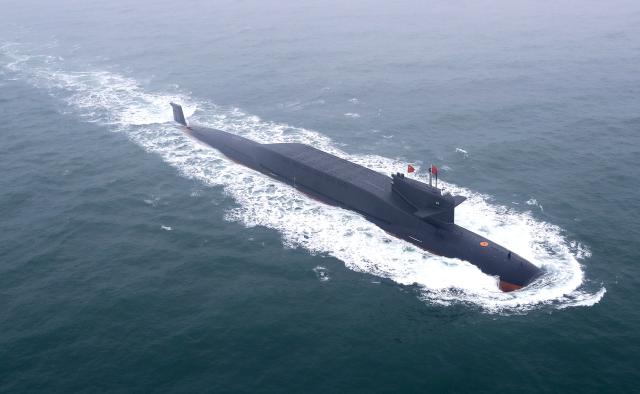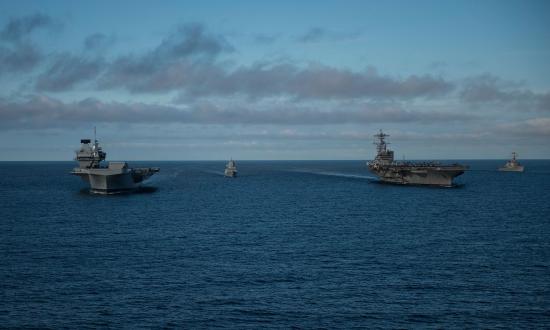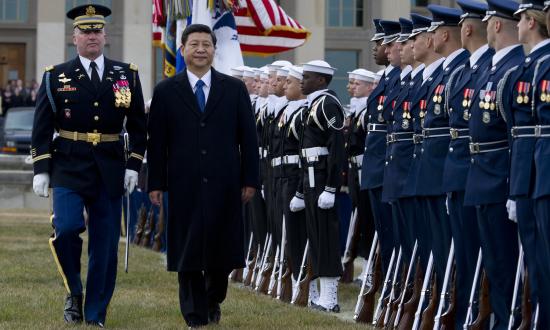Effective security strategies must balance four key variables: ends, ways, means, and the security environment. If one variable degrades significantly, the rest must adjust to restore equilibrium; otherwise strategic risk can quickly increase to an unacceptable level.
Today we live in a deteriorating security environment. The global operating system that kept the United States and its allies secure and prosperous in the wake of the world wars is gradually unraveling. Meanwhile, overattention to the distractions of extremism and self-alienated nations has masked persistent decay in the U.S. military’s capability and capacity relative to ambitious major competitors.
This erosion may hasten the end of the most recent
in a series of long-wave geopolitical cycles, which usually culminate in a war the belligerents did not expect. A major test of U.S. power, which some would contend is already under way, could signal the end of the current cycle.
As this geopolitical tapestry unfolds, it is unlikely that the ends of U.S. strategy—namely, the country’s place on the global stage and its enduring security interests—will adjust to restore equilibrium. Nations with empire-like status do not readily lower their ambitions, even if doing so sometimes makes sense. This leaves only ways, which are the strategic and operational concepts the nation uses to protect its security ends, and means, which are the tools in which the nation invests to do so, available to address the growing imbalance among strategy’s four variables.
The U.S. military tends to seek additional means and to evolve operational concepts before turning to new strategic ways. This is understandable, as the latter is the more difficult type of change. However, when it becomes clear that enhanced means—in the form of more and better forces—are unavailable because of budget constraints, have been selected unwisely, or are simply inadequate to prevail in the new environment, it is necessary to seek new strategic ways. This will require courageous leaders who understand how disruption occurs, are able to face uncomfortable truths, and can overcome long-held paradigms. Such a shift will drive a somewhat different mix of means and operational concepts.
For the sea services, the imperative is mostly about China.
The End of History, This Time Around
Extended geopolitical cycles begin after extraordinarily bloody conflicts, in whose aftermath statesmen attempt to establish a system to preclude the catastrophe from ever happening again. Toward the end of a cycle, however, memories of the horrible costs of war fade and attention shifts to the turmoil of contemporary issues. Political hubris, nationalism, economic disparities, and blame-shifting can quickly lead to major conflict—and it may be happening again right before our eyes.
Hal Brands and Charles Edel describe this phenomenon in their book The Lessons of Tragedy:
The U.S.-led international order has been so successful, for so long, that Americans have come to take it for granted. They have forgotten what that order is meant to prevent in the first place: the sort of descent into violence and great-power war that has been all too common throughout human history.1
The current cycle’s preventive system includes a raft of organizations, laws, agreements, alliances, and standards held together by the glue of diplomacy, free trade, rule of law, values, and deterrent military capability. All are under assault from both outside and within.
Restless states are challenging the legal strictures and values underpinning the system with impunity. Examples include election interference, murders of political opponents overseas and at home, invasion or destabilization of neighbors, state-supported industrial espionage, creation of islands where none previously existed, and cyber attacks. Ambitious and resentful, China and Russia are on the offense. The growing unwillingness of free nations, mostly due to shifting economic realities, to hold those agitating against the system accountable for their actions only further erodes it.
Meanwhile, the United States’ neglect of its diplomatic corps, its scratchy and transactional relationships with long-standing allies, and its own deep internal political turmoil and fiscal irresponsibility combine with growing nationalism in democratic nations to further threaten the system from inside. Nations such as China feed on the resultant narratives and opportunities, while U.S. allies nervously wonder about the reliability of their most important partner.
The end is never certain until a tipping point occurs. Thucydides suggests it will be some combination of “the strongest motives . . . fear, honor, and interest.”2 Will it be prompted by a leader under political stress needing an external distraction? Or some one-off seemingly minor event? As scholar Graham Allison points out, “the proximate causes of war are undeniably important . . . [but less so than] the structural factors that lay its foundation.”3
One of the most important levers in avoiding cycle-ending major war is deterrence founded on credible military power. While not yet hanging by a thread, U.S. deterrent power is under increasing pressure.
If They Counter My Dragon . . .
The U.S. military’s current strategic ways view adversaries’ militaries as their centers of gravity and are founded on the ability to conduct offensive power projection to protect U.S. interests. But both the character of war and the balance of military power with these rising powers are changing. The National Defense Strategy fact sheet acknowledges the latter: “If unaddressed, eroding U.S. military advantage versus China and Russia could undermine our ability to deter aggression and coercion in key strategic regions.”
While the U.S. military was sidetracked by two decades of expensive counterinsurgency operations, China exploited organic development, acquisitions, joint ventures, and outright theft to narrow gaps in its conventional capabilities while simultaneously opening new, asymmetric ones. The United States now faces first-rate submarines and antiship weapons; sophisticated cyber capability; hypersonic weapons; disrupted space operations; advanced electronic warfare systems; conventionally armed ballistic missiles; and modern mines. Soon this could include countervalue cyber attacks, attacks on undersea cable infrastructure, custom-designed soldiers, certain artificial intelligence (AI) applications the United States has eschewed, and electromagnetic weapons.
These advances have made it more hazardous than ever for U.S. forces to operate exposed, whether from fixed bases or ships. British and Argentine losses in the Falkland Islands, U.S. experience in the Arabian Gulf, and recent Iranian precision-missile attacks on Saudi and Iraqi territory are reminders that the offense has gained a significant advantage over platform defense in this arena.4
But the starkest asymmetry lies in the information domain. Recognizing the dramatic costs of major state-on-state warfare, rising authoritarian nations are treating hard-to-attribute information warfare as a core capability. These nations exert tight control over their populations yet are free to influence others’, and they exploit this asymmetry on a daily basis.
Moreover, future adversaries will not fight the way we expect them to. How a conflict starts will profoundly affect how it is fought. The Chinese are tuned not to a Mahanian world of decisive conflict at sea, but rather to Sun Tzu’s guiding principles of “subdue the enemy without fighting” and “all warfare is based on deception.”5 Unlike Saddam Hussein, they will not allow the U.S. military to build up forces for a fight suited to its preferences. Rather, they will design for a fait accompli, aiming to control escalation below total war.
The overmatch that enabled the United States to overcome the tyranny of distance in the Pacific is fading. According to one commentator, “The Pentagon has reportedly enacted 18 war games against China over Taiwan, and China has prevailed in every one.”6
. . . I’ll Build More and Better Dragons
The first instinct of a military sensing its warfighting edge slipping away is to ask for more and better means, while sticking with its longstanding strategic ways. U.S. culture—including the services, combatant commanders, and congressional supporters—encourages this.
Regarding more means, the service chiefs are judged primarily by the numbers of ships, squadrons, or troops they maintained during their watch. Combatant commanders, living with plans that are growing harder to execute, demand additional forces, thereby reinforcing service budget demands. Congress supports larger forces because it means more resources in the form of systems either built or based within the districts of those with power. But having more stuff is expensive: The U.S. Navy is being forced to extend achievement of its 355-ship fleet because of the simple mathematics of buying, maintaining, and manning it.
Regarding better means, most service modernization efforts support offensive action. These include unmanned systems, stealthy fighters, hypersonic weapons, command and control to allow rapid engagement of thousands of targets, and artificial intelligence to improve lethality. Many of these systems are intended to enable fighting from outside antiaccess zones. But conflicts that culminate long geopolitical cycles are sustained and intense; winning under the current force-on-force concept requires getting in and mixing it up. That will work only if the vulnerability of exposed forces is addressed. As such, the only platforms and weapons that will remain relevant are those using concealment or that can credibly defend themselves.
The need for concealment suggests more investment in all forms of undersea warfare, where the United States still retains the edge in most areas. The nation’s industrial capacity at the high end of this capability—namely, nuclear-powered attack submarines—is stretched by the recapitalization of the sea-based nuclear deterrent. So, while the Navy is developing other undersea systems, far more resources should be dedicated to disruptive undersea capabilities, including unmanned systems and mines, even at the expense of other platforms and weapons.
Credible defense of exposed forces suggests more aggressive development of “speed-of-light” weapons to complement existing kinetic defenses. Unfortunately, absent a breakthrough, the physics of laser weapons limits them to countering relatively close-in threats in good weather, but high-powered microwave (HPM) weapons hold exceptional promise. They have demonstrated lethality at longer ranges versus electronics-dependent weapon systems.7 HPM weapons negate unfavorable cost and magazine exchange ratios and work in all weather conditions. The Department of Defense has expressed interest in them, and China almost certainly is developing them.8 It is time for the Navy to go all-in.9
There is no need to immediately jettison the prevailing strategic concept—as long as the money for “more and better means” is available, the fight for which the United States is preparing is the one that is presented, and the military invests wisely in more survivable systems. However, the concept eventually will fall short against a creative, agile, ambitious, geographically advantaged, and increasingly capable adversary.
The United States must formulate a new strategic concept to protect its ends before it is needed.
Finding Another Way to Win
Much has been written about businesses that allowed themselves to be disrupted and disappeared overnight by falling into an equilibrium Richard Pascale calls “the precursor to death.”10 It often occurs because an organization continues to devote resources to a moribund concept. Leading, rather than falling prey to, disruptive change demands that the United States unleash its best minds to challenge its existing strategic ways.
What might a renewed strategic concept for deterring hostile Chinese actions look like? First and foremost, it must align with deterrence’s two key pillars: imposing costs and denying objectives. It would rely mostly on the former, while employing a more defensive, less costly approach for the latter.
Imposing Costs
The highest art of imposing costs is understanding a competitor’s worst fear and treating that as its center of gravity. For any authoritarian system, that worst fear is of its own people. Put another way, when regime change occurs in a democracy, the losers go off to work in think tanks. Something different happens in an autocracy, and they know it.
China’s backsliding into greater authoritarianism under Xi Jinping—including the “re-education” of millions of Uighurs, control of the internet, use of facial-recognition technology, and other oppressive measures—is a clear indicator of its concern over control of its population.11 Though some view increased engagement begun under President Richard Nixon as a blunder, it introduced a mounting vulnerability: The Chinese people have high expectations for participating in a middle-class consumption economy.12 As James Fallows notes: “[F]or China the short-term stability and long-term improvement of jobs, wages, and living standards are fundamental to the government’s survival . . . sustained economic failure would naturally raise questions about the system as a whole, as it did in the Soviet Union.”13
Touching China’s foremost anxiety thus would focus on holding at risk its ability to control its population—a concern on full display during the COVID-19 epidemic and ongoing tensions with Hong Kong. The principal levers initially would be beefed-up and well-coordinated diplomatic, economic, and information instruments of national power to threaten the so-called Mandate from Heaven—but the military instrument could provide the coup de grâce were major hostile Chinese action threatened.
Military support for the economic instrument would require the ability to disrupt China’s emerging Belt and Road Initiative network. This initially might include nonlethal means of stopping ships, interference in the command and control of the flow of goods, and other methods of confounding exports. More direct action would include, among other capabilities, covertly delivered advanced mines that can engage different types of targets under different escalation conditions.
Military support for the information instrument would acknowledge this new element of war. It would employ AI-empowered countervalue information warfare to target China’s control of its population, as well as to counter Chinese messaging efforts around the world. This would be challenging because of the barriers emplaced by China, but no social information system is impenetrable. The high end would be served by tools—such as cyber attacks on infrastructure—that should be developed and placed in reserve.
Denying Objectives
The other half of the concept—denying objectives—requires holding at risk exposed Chinese forces executing hostile actions by using more antiaccess capability applied in reverse and less offensive action. A premium would be placed on undersea warfare, better antiship missiles, transformational missile defense, and more ubiquitous air defense. Enhanced defense of the U.S. homeland would be vital, as rising powers will not take kindly to efforts to undermine their population control and are developing the ability to target the United States with conventional weapons.
Because deterrence exists in an opponent’s mind, thoughtful decisions regarding attributability and disclosure timing of some tools will be required to most effectively leverage their deterrent value. That the naval services can employ so many of them without relying on other nations is important.
A new way does not suggest the decline of U.S. power or influence or withdrawal from the region. It is merely designed to sustain U.S. security ends while addressing both a dramatically changing security environment and the looming limits on greater means. While the current force mix still will be useful globally, under a new strategic concept it can be smaller, look and operate differently, and be less expensive than the current approach. As Sun Tzu tells us, “Great results can be achieved with small forces.”
‘They can live in my new world, or they can die in their old one’14
The Sea Services are not alone in their allegiance to old ways that make them vulnerable to disruption. A similar challenge exists in Europe, where a timeworn model—deploying a large, heavy force across the Atlantic in time to defeat an adversary that enjoys several key advantages—is confronted by both old and new realities.15 New ways and, as a result, a different mix of means are needed there as well.
Fortunately, major conflict with a rising power is not inevitable, and every effort should be made to avoid one. But history repeatedly has shown that politicians’ hubris can quickly lead to cycle-ending tragedy. Thus, the contribution of ways to long-term balance in the strategic equation demands renewed attention.
This will require imagination and resolve from the senior-most civilian and military leaders, who must drive the creative process, skillfully communicate new ideas, forge different budget taxonomies to enforce discipline, and work closely with Congress. But it would be strategic malpractice were long-held assumptions, service cultures, congressional parochialism, devotion to waning concepts, or a lack of imagination to lead to failure to protect U.S. security ends.
Graham Allison offers the imperative: “We must be willing to think the unthinkable—and imagine the unimaginable.”16 Historian B. H. Liddell Hart alerts us to how difficult it will be: “The only thing harder than getting a new idea into the military mind is getting an old one out.”17 Theodore Roosevelt warns of the cost of not doing so: “Americans learn only from catastrophe and not from experience.”18
Winter is coming, we just don’t know when. And we have much to do to prepare.
1. Hal Brands and Charles Edel, The Lessons of Tragedy: Statecraft and World Order (New Haven, CT: Yale University Press, 2019), 5.
2. Thucydides, History of the Peloponnesian War, 1.76.
3. Graham Allison, Destined for War: America, China, and Thucydides’ Trap (Boston-New York: Houghton Mifflin Harcourt, 2017), xiv.
4. LCDR Jeff Vandenengel, USN, “Fighting Along a Knife Edge in the Falklands,” U.S. Naval Institute Proceedings 145, no. 12 (December 2019): 62–67.
5. Sun Tzu, The Art of War, trans. Lionel Giles (New York: Barnes and Noble, 2012), 6, 10.
6. See Fareed Zakaria, “The New China Scare,” Foreign Affairs (January/February 2020): 52.
7. For a description of this event, in which a Light Marine Air Defense Integrated System was used to defeat an unmanned aerial vehicle, see Brian Barrett, “The Marines’ New Drone-Killer Aces Its First Real World Test,” Wired, 22 July 2019.
8. See Ben Werner, “Pentagon Shifts Focus on Directed Energy Weapons Technology,” USNI News, 5 September 2019. Excerpt from Richard D. Fisher Jr., “China’s Progress with Directed Energy Weapons,” testimony before the U.S.-China Economic and Security Review Commission hearing, “China’s Advanced Weapons,” 23 February 2017: “Chinese media hailed Huang Wenhua . . . [who] won a first prize in a national technology award series for having developed a HPM weapon capable of defending warships from anti-ship missiles.”
9. See Congressional Research Service, “Navy Lasers, Railgun, and Gun Launched Guided Projectile: Background and Issues for Congress,” 17 December 2019. This document does not mention high-powered microwaves.
10. Specifically, “When a living system is in a state of equilibrium, it is less responsive to changes occurring around it. This places it at maximum risk.” See Richard T. Pascale, Mark Milleman, Linda Gioja, Surfing the Edge of Chaos (New York: Three Rivers Press, 2000), 6.
11. See Lindsay Maizland, “China’s Repression of Uighurs in Xinjiang,” Council on Foreign Relations, updated 25 November 2019.
12. See Kurt M. Campbell and Ely Ratner, “The China Reckoning: How Beijing Defied American Expectations,” Foreign Affairs (March/April 2018).
13. James Fallows, “China’s Great Leap Backward,“ The Atlantic, December 2016.
14. Spoken by Daenerys Targaryen in Game of Thrones, season four, “Mockingbird.”
15. Carter Ham, “A U.S.-Based Army Can’t Get to the Fight Fast Enough,” Defense One, 3 March 2017.
16. Allison, Destined for War, xx.
17. B. H. Liddell Hart, Thoughts on War, 1st ed. (London: Faber and Faber, 1944).
18. Theodore Roosevelt, Autobiography of Theodore Roosevelt (New York: Simon and Schuster, 2013), 158.








